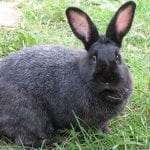Scientific Facts
| Common Name: | Rhinelander |
| Scientific Name: | Oryctolagus cuniculus |
| Life Span: | 5 to 8 years |
| Size (Adult): | Large |
| Weight (Adult) | 6.5 to 10 pounds |
| Habitat: | Forests and meadows |
| Body Shape: | Full-arch |
| Country of Origin: | Germany |
Physical Description

The Rhinelander is a rabbit breed with a medium-sized body. It is a domestic rabbit that has roots in Germany. It is known for its distinct facial markings like the famous butterfly mark. It also has unique marks on the spine, colored ears, eye circles, side marks, and cheek spots. The spots range from black, brown, and fawn-colored. The Rhinelander is recognized by the American Rabbit Breeders Association ARBA and the British Rabbit Council or the BRC.
The Rhinelander was first bred in Germany in the early 20th century. These were soon exported to other nearby countries during the 1920ss. This is a popular breed in Germany, but the interest reduced in the 1930s because of the popularity of the Checkered Giant and the post-war effects of WWI.
However, after WWII, the Rhinelander became more popular once more, and soon, it became very popular worldwide. In the United States, the popularity of the Rhinelander was on and off, especially its long absence from 1932 to 1972. The breed was again re-established in the US during the 1970s, and this resulted in the creation of the first Rhinelander breed club called the Rhinelander Rabbit Club of America in 1974.Today, the Rhinelander breed is rare in the United States and the UK.
The Rhinelander is an arched breed meaning that when it is placed against a light source, the light will show between the body and the ground where the specimen is placed seated or moving. This appearance is similar to another arched breed known as the Checkered Giant breed, but the Rhinelander is smaller.
The Rhinelander has a trim and athletic look, with the body the same size from the rabbit’s shoulders to the hip. It is very popular for its distinctive coat pattern and for its unique butterfly markings, which is seen over the nose and upper jaw. The shape of this mark looks like a butterfly.
The BRC states that the weight of a Rhinelander should be from six to 10 pounds while the ARBA says that the weight of this breed should be from seven to 9 pounds.
Coat and Colors

When it comes to color markings, the BRC recognizes only a white base with black and yellow marks along the face and the back. Meanwhile, the ARBA said that there is a blue and fawn spotting mark against a white background, aside from just the black and orange patterns.
The Rhinelander coat is soft, short, and dense and won’t need too much care to maintain. It should be brushed at least once a week and more often during off-season during the shedding. This will remove any dry or straight hair.
This rabbit will have two molting seasons in a year, and during this time, you must brush your rabbit using a slicker brush to keep it from shedding.
Most pet owners are concerned about using hygiene products on their rabbits. Since you can’t bathe your rabbit, how do you clean its fur thoroughly? The answer is an ingenious shampoo called a no-water, no bathe shampoo. All you need to do is to wipe the shampoo on the fur of your pet and massage it gently. Afterward, wipe the shampoo with a damp cloth and then a dry cloth to remove any residue. As mentioned, never give your pet a bath. It is stressful and can even make your rabbit ill.
Fast Facts
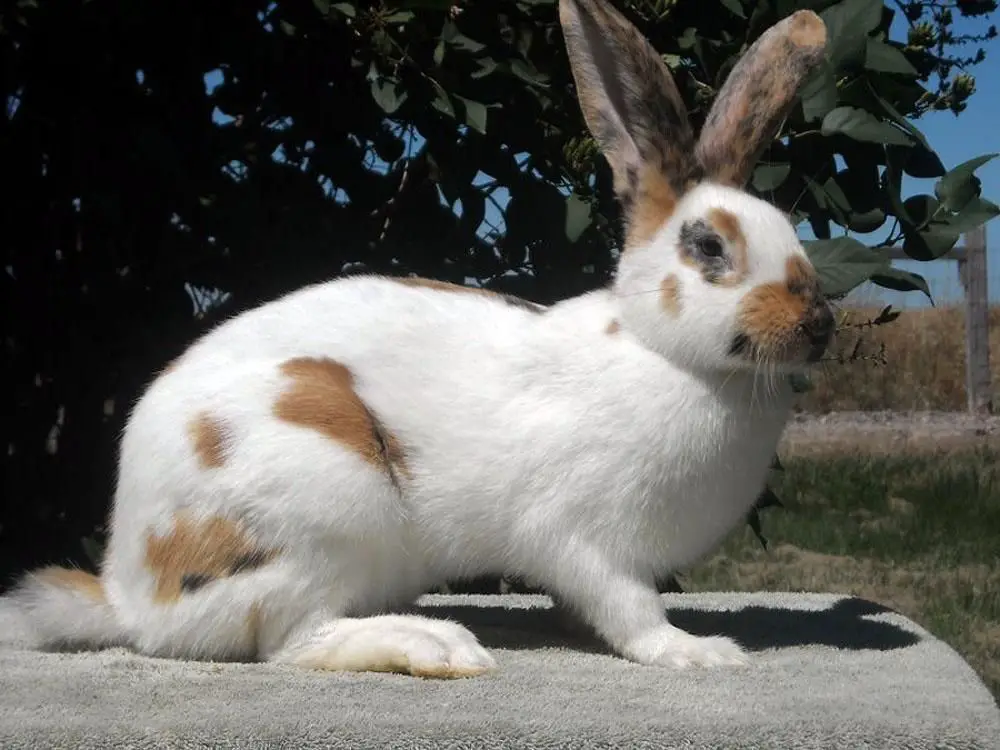
The Rhinelander can live up to 8 years with some breeders claiming that their own rabbits can grow more than 10 years. It is a large breed and is best for singles, seniors, and families within apartments, children and first-time rabbit owners. It is a friendly, docile, and gentle rabbit that can become good companions.
History of the Breed
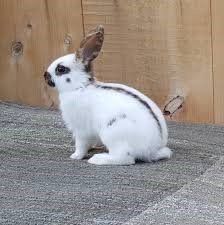
The Rhinelander rabbit was initially spotted in trade shows and events in 1902 in Germany after this was bred in North Rhine-Westphalia. Experts believed that his breed was made by combining the genes of a Harlequin buck and a Papillion doe.
A buck from the litter possessed the marking that the Rhinelander breed will be famous for the celebrated black and orange in color on the chin, ears, and the butterfly mark on the nose.
Still, another cross was made, but this time, it was with a Harlequin buck and a large Checkered Giant doe. The result was a litter with one doe that possessed the celebrated marks.
The buck from the first litter and the doe from the second litter were mated, and the does from the resulting litter was mated with the Harlequin bucks to preserve the Rhinelander breed. It was in 1905 when a standard was made to honor the Rhinelander in Germany. The breed was named Rheinisshe Schecke.
The first Rhinelander rabbits were exported to the Netherlands and England in 1924. The new breed was a hit, but soon, people lost interest as well as the number of breeders who wanted to try the breed. Basically, the tedious selective breeding process and the required color combinations and markings were too much for breeders. In addition, Rhinelander was mainly bred for sport rather than for meat, and this made many people lose interest.
By 1930, only a few breeders were able to preserve the process of breeding Rhinelander. After WWII, interest in the breed began to increase, and thus, it became one of the most popular spotted breeds in Germany in 1978.
The first time Rhinelander was exported to the US from Germany was in 1923. It was soon recognized as a breed by the US National Breeders and Fanciers Association. However, by 1932, no Rhinelander remained in the US because it was just too complicated to breed. Rabbit breeders also focused their attention on breeding the Checkered Giant rabbit.
It was in 1932 when an American rabbit breeder visited Germany and saw the Rhinelander in a show and took with him four specimens from the country back to the US. In 1974, the Rhinelander Rabbit Club of America was founded, and a year later, the breed was recognized by the American Rabbit Breeders Association.
Additional Rhinelander was imported to the Netherlands and Germany to deal with inbreeding among the limited number of Rhinelander in the US. There were breeders who crossed the Rhinelander with a Checkered Giant or a Harlequin to preserve the breed. The American breed standard for the Rhinelander was re-written and improved afterward the interest to the breed gradually improved.
The Rhinelander is a part of a closely watched breed by the Livestock Conservancy. This means that there are less than 2000 rabbits in population and less than 200 registrations in the US yearly. The UK also recognized the urgency to protect the gradually decreasing population of Rhinelander. This breed is designed as a part of the BRC’s Rare Varieties Club.
Temperament and Behavior
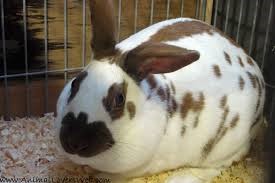
The Rhinelander is a docile and patient creature and thus will work best as a first-time pet for families, singles, seniors, and homes with children. These rabbits are cute, cuddly, and children won’t be able to resist holding and hugging it. Of course, the Rhinelander won’t mind!
The Rhinelander is patient, as it can be the sole focus of the attention of a child in play. It will permit a child to tug its ears or holding it awkwardly because of its kind and gentle nature. Some say that the Rhinelander has earned this gentleness because of breeding and inbreeding. It was able to preserve its good looks and its many impressive natural qualities.
It is soft, cuddly, and not as heavy as French Lops or Contis; therefore, a child can handle it with two hands. It will permit you to carry it and hold it in public and will always welcome a pat and even a kiss on top of its head.
Allow a young Rhinelander to approach you without fear. Sit on the floor with him and hold a treat. Let it find your hand and to bravely move towards you. The first time, it will be skittish and may not be trustful, but soon, it will see that you mean no harm, and you bring treats too! Do this regularly, and you can bet that your rabbit will trust you for life.
As a Rhinelander is patient with its human family and its owner, it is also a good soul in a rabbit’s cage. It will not pick fights or will never be aggressive with other rabbit pets. It will also be sociable and will gladly eat with other rabbits and even groom with them. Social grooming is said to strengthen the relationships of members of the group. In addition, there is no hierarchy in a Rhinelander’s cage, and everyone has equal rights to the cage areas.
A Rhinelander also has a laid back attitude and being so; it is in danger of becoming overweight or obese. Eating too many calories and not moving much can make your rabbit fat. You can prevent this by playing with it, running, and playing tag with it inside its large enclosure. If you must take it out, make sure to rabbit-proof everything before you take the rabbit out of its cage. Most rabbits will love running and will gladly run to bond with their owners.
Finally, Rhinelander is easy-going rabbits and will always be happy to have company. Most Rhinelander owners say that they are glad to have this breed as a pet because this is easy to care for and won’t’ be a problem when it comes to behavior and temperament.
Comparable Breeds
Comparable breeds to the Rhinelander is the Checkered Giant, which is another medium to large rabbit breed and has similar spots and markings like the Rhinelander. This breed is also docile, friendly, and is easy to care for and breed. It was used to breed the Rhinelander and to strengthen its characteristic appearance and traits. The Checkered Giant is a giant breed of rabbits, which can weigh up to 13 pounds. It can live up to 6 years, which is a short lifespan due to its massive size.
Another comparable breed is the Harlequin Rabbit, which is a medium to large rabbit breed, which can weigh from 6.5 to 9.5 pounds. It can live up to 8 years, a very short lifespan because of its large size. It is a commercial rabbit that’s best suited for singles, families, and people who live in houses and apartments. The Harlequin rabbit is another gentle giant, is sweet, active, and curious.
Fun Facts
Rhinelander comes with different markings and colors, and this has made it unique. Do you know that no two Rhinelanders are alike when it comes to color distribution and markings? You may think you have found exact-looking or identical rabbits, but still, these specimens will still have some distinct differences.
Care
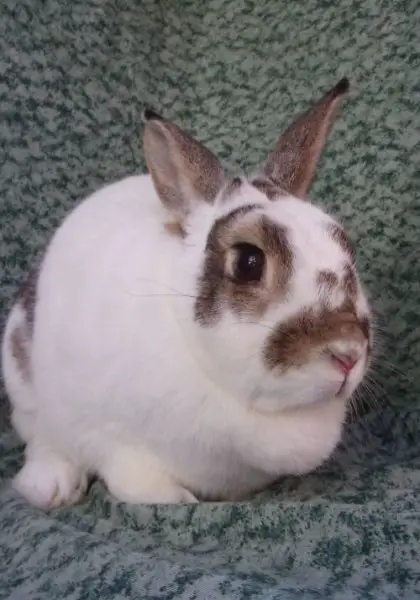
Although Rhinelander rabbits are large, these need the same care as with other smaller rabbit breeds. This means you must give your pet the correct diet, housing, companionship, training, and access to good health care.
The main food of rabbits like the Rhinelander is hay. This is the bulk of their diet. You may also give commercially-made pellets designed for rabbits, which contain the needed vitamins and minerals for proper growth. Vegetables and fruit may also be given.
You must also make sure that your rabbit cage will always have a fresh supply of water daily. The enclosure must have unlimited amounts of hay, as well. Hay is very helpful in keeping their digestive tract regular and healthy. A quality pellet is also needed for correct nutrients, but water and hay are considered staples.
Rhinelander is considered a docile and easy to care for the family pets. And pet owners should watch their rabbits closely for any signs of illness. Pet owners should also interact with their pets daily. An owner who spends time with their pets is more trusted by their pets than those who don’t interact with their pet rabbits. Most rabbits thrive well and live fruitful lives because of being close with their owners.
Spaying or Neutering
Controlling the rabbit population is important, especially when you want to breed rabbits in captivity. The best way to control the population is by spaying or neutering. This must be done while your rabbits are still at a young age. However, most vets wait until their pets are six months of age in order to observe the safest ways for spaying. And despite bucks may be neutered at a young age, or as young as three months to make them less aggressive, they actually unaggressive. This could mean that neutering bucks are not needed at all. Talk to your vet regarding the best practice when it comes to spaying and neutering your pet Rhinelander.
Supplies and Cages
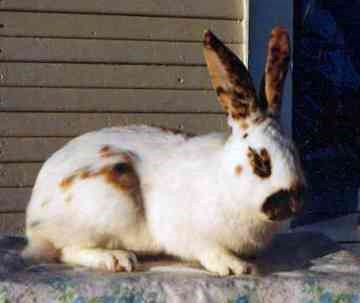
The cage of your Rhinelander should be a wire enclosure with a plastic tray at the bottom. The bottom portion of the cage should have soft bedding so that it is comfortable for your pet. Place a rabbit hay feeder along the side of the cage. This will allow your rabbit to pull hay out and chew if they feel hungry. Make sure that this feeder is filled with hay all the time.
For the rabbit bedding, use aspen, wood pellets, or pelleted horse bedding. Avoid giving them cedar or pine. Aspen and wooden pellets will absorb odor and urates very well and thus can make cage management easy.
The cage may be cleaned by using a cage cleaner or natural cleaners like white vinegar. Avoid using home cleaners or other cleaning materials that may be toxic for your pet rabbit.
Daily spot cleaning of the cage bedding is recommended and replacing it every week. This helps in getting rid of droppings, which is essential in keeping the rabbit home, fresh, and clean. This is good for hygiene and also for the owners because it reduces any kind of annoying smell.
Rhinelander, just like other rabbits, is very clean animals and will take time to groom themselves, and even each other. Rabbits are crepuscular, which means that they are usually active in the daytime and in the evening. This is why feedings are mostly given in the evening.
Rhinelander sleeps for an average of 8 hours. Also, rabbits love socializing and living in groups, which means that you may want to consider this if you want to take care of a big group of Rhinelander.
Indoor vs. Outdoor Cage
Should you place the cage of your Rhinelander indoors or outdoors? If you can’t decide, remember the following pros and cons. Take note that rabbits that kept indoors usually have longer lives are more social and are happier.
Meanwhile, rabbits that live outdoors are skittish and vulnerable to weather changes, extremes in temperature, pests like mites and fleas, predators like cats and dogs, and other complications. If you want to keep your rabbits inside but do not have space, you can prepare an outdoor cage for your pets to play and run around.
Outdoor cages are easier to clean and will give your pets more room for playing and running around. Hosing the cage and brushing with a strong brush may be all you need to keep the cage clean and well-maintained. However, the cage should be kept away from direct sunlight and also from damp areas. The cage should be well protected against predators such as other pets at home like cats and dogs.
Health Concerns
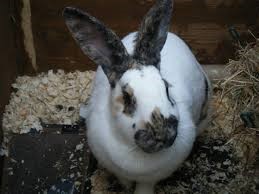
Rhinelander is not immune to common diseases among rabbits. Therefore, you should check for possible signs of illnesses, and your pets must receive standard vaccinations. Consult your vet for a complete list of vaccinations that your pet needs.
Some rabbits must be checked against digestive system problems. Take baby rabbits to the vet to check for enteritis, bloat, and intestinal stasis, especially if the babies are less than 8 weeks old. Also, look for ear or fur parasites like mites, fleas, and ticks. This is usually due to poor hygiene, incorrect husbandry, and lack of pet management.
Always be on the lookout for signs of ill-health like lack of appetite, not drinking well, nasal and eye discharges, constipation, diarrhea, difficulty in breathing, sleeplessness, changes in gait, and signs of pain and so on.
Teeth
A part of taking care of Rhinelander is the regular checkup of their teeth. This ensures that their teeth do not overgrow. Rabbit teeth tend to grow too long, causing pain since the teeth grow right into the rabbit’s mouth and jaws.
To prevent teeth overgrowth, a diet rich in hay is recommended as it files down the rabbit’s teeth as they chew. Always check your rabbits’ teeth by gently opening their mouths. By keeping an eye on your rabbit’s dental health, you can save yourself from the costly vet and dental bills.
Grooming
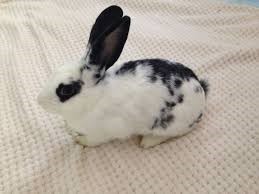
Rhinelander may practice self-cleaning, but still, these need regular grooming once a week. You may do it more when they are molting in order to prevent wool blocks. Rabbits may ingest their fur, and this accumulates inside their digestive system that can lead to blockage.
Do not bathe your rabbits as this will only stress them. Do spot-cleaning with a damp towel if they are dirty and follow with a dry towel to dry them off.
Remember to trim their nails every month using a nail clipper, or you may ask your vet to do this if you’re unsure what to do. Also, check for overgrowth teeth. Their cages must also be spacious enough to allow them to move freely.
Breeding
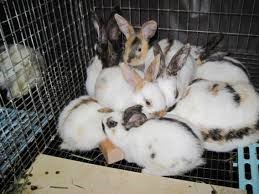
Rabbits should be at least 6 months before breeding, and although the bucks can be as young as 4.5 months, it is best to wait until 6 months, so they are ready to mate. For male rabbits, make sure that their testicles have descended.
The gestation period is 28 to 33 days, and most of them do deliver their babies at 30-31 days. Before starting to breed rabbits, choose a date that you want your females to give birth so that you’ll be there to help the doe give birth and ready the nesting box. You should also be around for two months wherein the babies should be weaned from their mother, to avoid any issues from weaning.
Rabbits can conceive and give birth any time in a year, so it’s best to plan everything carefully. During the hot summer months, babies can make the mother uncomfortable. However, it is also risky for the babies to be born in the wintertime because it’s very cold. Baby rabbits are usually born hairless. If the babies don’t do well, these could die. Spring and autumn are the best times for becoming pregnant and giving birth.
Organizations and Clubs
Because of the popularity of this breed, a number of organizations and clubs composed of Rhinelander lovers have been established. In 1923, this breed was recognized in the US by the National Breeders and Fanciers Association. In 1974, the Rhinelander Rabbit Club of America was established. In 1975, the breed was supported by the American Rabbit Breeder’s Association.
Recently, the Livestock Conservancy has placed the Rhinelander in a watched status because of its slowly dwindling numbers. And in the UK, the BRC has placed the Rhinelander in the Rare Varieties Club.
These are just a few of the many clubs and associations that support the Rhinelander breed. Not mentioned are the clubs established by local Rhinelander supporters and breeders. And despite the differences in names, these clubs and organizations have one goal; this is to preserve the breed for generations to come.
Other Notes
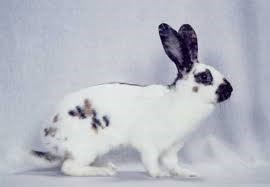
Rhinelander is also similar to regular rabbits because this love is chewing on things. They will chew on wooden furniture and any part of your home that’s made from wood. They may even chew on electrical wiring if these are available.
Avoid these mishaps and possible accidents by giving your pet hay or chew toys aside from their food. Also, everything that they eat should be clean and free from herbicides or pesticides. Younger rabbits need alfalfa hay, which is rich in calcium needed for their growing bones. The adult rabbits like legume hay, which supports a healthy gut. Always be careful about giving just any yard clippings to your rabbits. Choose organic food or, better yet, grow your own produce to feed your pet.
These rabbits should be kept in pairs for companionship. Breeders have observed that being with another rabbit enhances the rabbit’s health and happiness, even helping it live longer. Also, rabbits are very social, so you must consider taking care of more than one or two rabbits as a companion for your pet.
De-worming should be done in the spring and fall. There are many products used for de-worming pets, and one of these is a paste. A de-worming paste is easy to use; all you need to do is to put it in their mouth. This may already be sufficient for your pet rabbit.
Availability – Where to Get One?
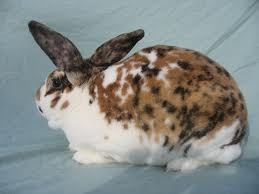
When it comes to the price of a Rhinelander, it may depend on whether you are buying from a breeder or not. Prices may also depend on where you are getting one for a show or as a pet. Searching for a reliable breeder is important to make sure that you are only getting a healthy rabbit and not one with genetic disorders like hooked spines or malocclusion. And if you want your Rhinelander for a show, you must use a purebred variety with no genetic disorders.
The cost of buying a pet online can be very expensive because of the cost of delivery and shipping. This is why some consumers just adopt a rabbit from a local shelter or buy from a local breeder to save money. Local adoption may not give you the breed you want, but you are helping an animal get a new lease on life by placing it in a new, loving home.
How to Care for a Rhinelander
Rhinelander rabbits are large, but these need the same care as with other rabbit breeds. You must give your pet the right diet, housing, companionship, training, and of course, access to good health care.
The main food for Rhinelander is hay. This is the bulk of their diet, but you may also give commercially made pellets made for rabbits, which contain the needed vitamins and minerals that your bunny needs for proper growth.
Vegetables and fruit may also be given, but these should be organic food. Breeders select the best produce by shopping in an organic shop or growing their own food instead.
Make sure that your rabbit cage will always have fresh water daily. Change the water inside the dish twice daily. The enclosure must have unlimited amounts of hay to let your bunny chew to prevent teeth overgrowth. Hay is helpful in keeping their digestive tract regular and healthy. A quality pellet food is needed for correct nutrients but always keeps water and hay inside the cage.
Rhinelander can be active in the morning or in the evening, so it is best to monitor your pet’s level of activity and to feed it only when it is active. Keep a diary of your pet’s daily activities and look for any signs that may show its sick or suffering from any medical condition.
Rhinelander is docile and easy to care for and thus preferred as a family pet. Owners must watch their rabbits closely for any signs of illnesses. They must interact with their pets daily to earn their trust and keep their pets well-behaved. An owner who spends time interacting with their pets is more trusted by their pets compared to those who do not interact with their pets. Most rabbits live well and fruitful lives because of being close to their owners.
FAQs
How much food can a Rhinelander eat daily?
A Rhinelander has a medium build; therefore, it needs more food. You must feed your pet twice daily and offer fresh hay in their cages. Water must be in a bowl, and this must be fresh and changed twice a day.
How do you prepare food for the Rhinelander?
Cut the fruits and vegetables into smaller pieces that your rabbit can easily chew. Cut leafy greens and other veggies into smaller pieces. Rabbits will not be able to hold their food and will just use their sharp teeth to hold food and nibble them. Meanwhile, you may also feed your bunny commercially-prepared pellet food because this is small enough for any rabbit; just pour the right amount in the bowl and feed it to your rabbit.
What does Rhinelander eat?
Rhinelander will eat almost anything, but it prefers to eat plants. The best diet should have hay to keep its digestion healthy, and its teeth ground to the right size; you can also give it vegetables and fruits as long as these are organic fruits and veggies.
Can you feed Rhinelander meat?
No, Rhinelander is herbivores and will not eat meat. Feed it hay, fruits, veggies, seeds, and commercially-prepared rabbit pellets. These are available from a local pet shop and supermarket.
Does Rhinelander drink more water?
Yes, Rhinelander needs more water than a regular rabbit. Place water and food in a large dish like a heavy doggie bowl to prevent from spilling as the Rhinelander eats and drinks. Wash these food containers daily.
Will the Rhinelander eat human food?
It will eat fruits and vegetables that you will eat, but make sure that these are organic because these will not contain chemicals or pesticides that can affect your pet’s health.
How to tell if your Rhinelander is overweight?
If the weight of your Rhinelander is more than the average weight, then your pet may be overweight. The best way to find out if it is overweight is to take this to a vet where it can be evaluated according to standard Rhinelander rabbit measurements.
Is there a weight limit for Rhinelander show rabbits?
There is a weight limit for Rhinelander, so if you want to someday take your pet to the fair, start placing your pet on a strict diet to monitor its health and weight.
What are Rhinelander’s favorite foods?
Rhinelander will love any kind of fruit and veggies. Carrots are perfect treats, but make sure to cut these into small pieces so these will be easy to bite and nibble.
How tasty is the meat of Rhinelander?
Those who have tasted Rhinelander meat say that it is tender, tasty, and perfect for pairing with wine. If you want to taste the best recipes, check out recipes online as well as videos that show how to cook rabbits.
Is Rhinelander active at nighttime?
Some Rhinelander is active at night, while some may sleep during nighttime. So as with all pets, monitor your pet closely and find out when it’s best to eat, sleep and rest.
When is the best time to feed Rhinelander?
Feeding time may depend on your pet. Some Rhinelander is active in the daytime while some prefer to sleep during the day, so with this example, feed your pet during the day.
Can you place Rhinelander in a cage with other pet rabbits?
Yes, Rhinelander can be housed together with other rabbit breeds inside an enclosure. This breed is sociable and will love being with other rabbits as they eat, sleep, groom, and play together.
How do you pick up a Rhinelander from the ground?
The Rhinelander is a medium-built rabbit, and therefore, you must be very careful not to drop this. Pick it up by holding on to its belly using your two hands. When you pick it up, carry it only a few inches from the ground.
Can you leave a Rhinelander rabbit alone outdoors?
Yes, you can leave your pet Rhinelander outdoors but only inside a fenced enclosure to prevent it from running away. You should never leave your pet out of your sight because there might be predators nearby.
Does Rhinelander mate for life?
No, Rhinelander doesn’t mate for life. This rabbit can even have different partners in one breeding season. Most rabbits are promiscuous, and thus breeding happens almost immediately when a female just gave birth.
Where do you place the Rhinelander cage?
You may place it in an indoor or outdoor space but consider the pros and cons. Indoor cages will allow you to keep watch and will secure your pet from the elements, but indoor enclosures are small with limited space to play, run and socialize. On the other hand, outdoor cages are susceptible to the elements and predators but are large for your pet where they can roam around, play, and socialize.
Can Rhinelander sleep in the dark?
Rhinelander will be able to sleep in the dark and in the light. These won’t mind if you turn off the lights in your room at all. Rhinelander sleeps near their cage mates and with their eyes closed and their heads huddled towards their bodies.
Can you use a clicker on your Rhinelander?
Some breeders say that a clicker can be used on Rhinelander, and they are able to practice even more complicated tricks using the clicker. Just like a dog, a Rhinelander will be guided by the clicker.
How heavy can a Rhinelander rabbit get?
A Rhinelander can grow as much as 10 pounds, and there are some breeders that say they have larger species in captivity. Remember that if your pet is heavier than 10 pounds, then this may be overweight.
Will a Rhinelander bite you?
Yes, a Rhinelander can bite if it feels threatened. Domesticated Rhinelander won’t bite and are often very timid with no aggressive behavior.
Will a Rhinelander be nice to children?
Yes, Rhinelander will tolerate young kids and may play with them as well. You will find children playing with Rhinelander rabbits by dressing their playmates up and by holding it like a baby.
Is this a good first-time pet?
No, this is not a good first pet due to its size. It has a sweet and kind demeanor, but its size can be a problem, especially for children.
Is a Rhinelander rabbit territorial?
No, Rhinelander is not territorial and will tolerate being in cages together with other rabbits and rabbit breeds. Unlike some animals that are territorial and will be aggressive once they spot males or females in the area, the Rhinelander will learn to live with these creatures and will not be aggressive at all.
Can a Rhinelander rabbit eat food from your hand?
Yes, Rhinelander is timid and easy to handle. Once it has gained your trust, you can hand-feed it and will readily eat from your hand. This rabbit loves treats and can learn new tricks by using treats and a clicker.
Will a Rhinelander eat hay?
A Rhinelander will eat hay, and this is important since hay is a staple food in their diets. Rhinelander needs hay to keep their digestive system regular and healthy, and their teeth trimmed to prevent overgrowth, pain, and injuries.
How much hay will a Rhinelander eat in a day?
Rhinelander is like other rabbits that will eat as much hay as it wants. Make sure to provide fresh hay and water daily inside its cage.
Is a Rhinelander aggressive towards other pets?
No, Rhinelander is not aggressive and will not show any aggression towards other rabbits when kept in a shared enclosure or aggression towards other pets.
How do you handle a Rhinelander?
To handle a Rhinelander, hold it by wrapping your arms around its body and slowly picking it from the ground. Never hold it high to prevent injuries in case
What is the best kind of bedding for Rhinelander?
There are many kinds of bedding for rabbits sand Aspen and cedar is the best bedding because these can absorb odor and moisture better and are also easy to clean.
What are the best toys to play with your Rhinelander?
There are many kinds of toys for your Rhinelander. You can use a cardboard toy or a moving toy to entice the rabbit to move and to exercise.
How do you train your Rhinelander where to pee?
Just like training a cat or a dog, after eating, take it to the area where it’s supposed to pee or poop and leave it alone for a while. When it’s done peeing and pooping, take it back to the enclosure. Do this without fail, and soon, it will remember where it needs to go.
Can a Rhinelander be trained to walk using a leash and collar?
Yes, you can teach a Rhinelander to walk with a collar and leash, and just like a dog, it will surely look forward to it daily. Train by placing the collar around it is neck first and then giving it a treat. When it is relaxed, take the leash and connect it to the collar and try to walk it. Start slowly and surely; never pull on your rabbit’s leash.
Will a Rhinelander kick?
Yes, Rhinelander has large hind feet that it can use to kick any threat. The large hind legs also keep it steady when it walks runs and moves inside the cage. The hind legs are also perfect for defending itself from other rabbits, but it rarely uses them in captivity.
Can you keep a Rhinelander as a pet from where you live?
A Rhinelander may not be welcome in some places, so be sure to check with local laws regarding the legality of owning and keeping a Rhinelander in your home. You may look for updated information from an animal local office or from your vet or animal specialist.
How do you clean the cage of a Rhinelander rabbit?
You must first clean by removing all the debris and feces. Spot clean by wearing gloves and a mask. Replace the bedding and clean your pet’s food and water dishes. You must also brush the cage bars with a good natural or chemical cleaning product always follow instructions on the product label if you want to use a chemical cleaner.
What is the best natural cleaner to maintain a Rhinelander cage?
Instead of using regular cleaning products that may be toxic to your pet, you can use natural cleaners like lemon, baking soda, and white vinegar. These will clean the cage more efficiently and will also remove smelly odors.
Can Rhinelander eat their young?
Some Rhinelander mothers will eat her newborn, and so far, no one knows why it is doing this. However, if you spot your rabbit eating her young, immediately remove this from the enclosure, and this should never be allowed to breed anymore.
Can Rhinelander transmit rabbit diseases to humans?
Some diseases of animals may be transmitted to animals and to humans. In rabbits, there are no noted diseases that can be transferred to humans. Still be careful when handling rabbits by wearing gloves, masks, and gowns to prevent any possible contamination.
What are the pests that Rhinelander rabbits harbor?
Rhinelander rabbits may have ticks, mites, and other parasites, which can multiply and become harmful to their health. At the first sign of pests or parasites, take your rabbit to the vet for proper care.
How do you treat fleas in rabbits?
There are special flea collars and flea powder formulas that you can use on your rabbit. Follow the directions on the label for proper use. If fleas persist, take your pet to the vet for correct care.
What are the possible signs of illness in rabbits?
Rabbits are generally healthy but may also be vulnerable to certain rabbit illnesses. Watch out for diarrhea, constipation, poor appetite, lack of energy, dizziness, restlessness, and other signs.
